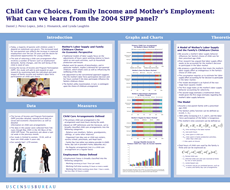
An official website of the United States government
Here’s how you know
Official websites use .gov
A .gov website belongs to an official government organization in the United States.
Secure .gov websites use HTTPS
A lock (
) or https:// means you’ve safely connected to the .gov website. Share sensitive information only on official, secure websites.
-
//
- Census.gov /
- Library /
- Census Working Papers /
- Child Care Choices, Family Income and Mother’s Employment
Child Care Choices, Family Income and Mother’s Employment: What can we learn from the 2004 SIPP panel?
Child Care Choices, Family Income and Mother’s Employment: What can we learn from the 2004 SIPP panel?
Introduction
- Today, a majority of parents with children under 5 depend on substitute care givers. The increased need for non-parental care refl ects the increase in maternal employment over the last 30 years and the desire for educational opportunities for young children.
- The task of selecting a child care arrangement often involves a number of factors such as employment demands, family changes, and the well being of the child in need of care.
- Using the Survey of Income and Program Participation (SIPP), this study will add to and expand on past research by examining both the individual and joint impact of family income and mother’s labor force participation on child care choice.
Mother’s Labor Supply and Family Childcare Choice: An Economic Perspective
- Traditional models of labor supply focus on the adjustments of hours spent working relative to hours spent on non-work activities, such as household production and leisure
- Market work for parents of preschoolers, and in particular mothers, implies a demand for non-parental childcare, which entails costs as well as influencing the wellbeing of the child
- An adjustment to the conventional approach suggests that the mother’s labor force participation decision and her hours worked if she does participate influence the family’s childcare choice
- The family’s utility maximization, in turn, is contingent upon the choice of childcare arrangement
Share
Some content on this site is available in several different electronic formats. Some of the files may require a plug-in or additional software to view.
 Yes
Yes
 No
NoComments or suggestions?


Top

